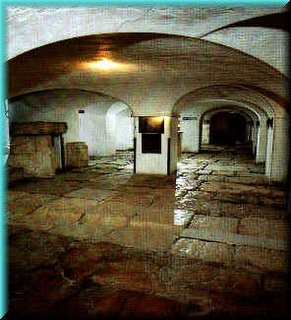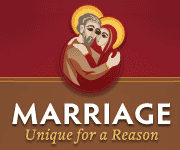What I Saw In The Holy Land 16
(See the post above before reading this.) Our first stop was the ruins of the fortress Antoninus, thought by long tradition to be where Pilate made his praetorium (which turns out not to have been a fixed place, but wherever the Praetor happened to be doing business). You're looking at the chapel of the flagellation, which is lovely --although a creepy 16th c. legend has it that you can hear Christ's persecutors scourging themselves in hell here if you're quiet. I didn't hear them, though, and indeed the pleasant sunshine and the young orange tree growing in the middle of the courtyard rather belay the gruesome scene I was supposed to be recalling.
We had a solemn and intimate mass here in the Ecce Homo chapel. You can see the top of the chapel is modern, but part of the wall is ancient. Can't you just see the desperately beaten Christ appearing through that arch even now? After Mass we descended to the "lithostratos," where Christ was kept until he was given his cross. You can see the huge Roman stones --some of which are etched with the games the guards used to play. The Franciscans loan you a big wooden cross to carry, and we took turns by twos shouldering it. Once you leave the lithostratos, you are out in the thick of the Muslim quarter, and we began our stations at precisely the moment (about 11) that literally tens of thousands of Muslims came streaming into the old city to attend
services at the Al-Aqsa mass.
I don't mind telling you I was frightened (the only time I felt threatened in my time there). The streets of the Old City are narrow and lined with vendors, and there is no place to run, really. So there we were, a Catholic priest and a bunch of women in Western dress, our very aspect confirming all the fanatics hate about the West, carrying a cross in the direction of the third holiest site in Islam. Our guide kept anxiously warning us not to do anything (additionally) provocative.
 With fear, however, comes a certain heightened awareness of your surroundings that I'm sure solidified my memories of that beautiful experience. I can still see the vendors with their carts of special breads and nut candies (most of the shops were closed for the Muslim sabbath), and the seeming wall of people streaming toward us (the streets are narrow, so they just keep coming and coming and coming). And I remember too, the strange happiness I felt when people cursed us. "Rejoice and be exceeding glad, for so persecuted they the prophets before you." It struck me that what I was experiencing certainly captured the flavor if not the intensity of what Mary & the other women following Christ must have experienced. They were following someone they loved and revered as God to his unjust death. And all around them there was hatred, or simple busy disinterest. I was humbled and grateful to join the steady stream of witnesses who've followed in Christ's path since the Franciscans formalized the practice (following what local Christians had always done) in the Middle Ages.
With fear, however, comes a certain heightened awareness of your surroundings that I'm sure solidified my memories of that beautiful experience. I can still see the vendors with their carts of special breads and nut candies (most of the shops were closed for the Muslim sabbath), and the seeming wall of people streaming toward us (the streets are narrow, so they just keep coming and coming and coming). And I remember too, the strange happiness I felt when people cursed us. "Rejoice and be exceeding glad, for so persecuted they the prophets before you." It struck me that what I was experiencing certainly captured the flavor if not the intensity of what Mary & the other women following Christ must have experienced. They were following someone they loved and revered as God to his unjust death. And all around them there was hatred, or simple busy disinterest. I was humbled and grateful to join the steady stream of witnesses who've followed in Christ's path since the Franciscans formalized the practice (following what local Christians had always done) in the Middle Ages.



